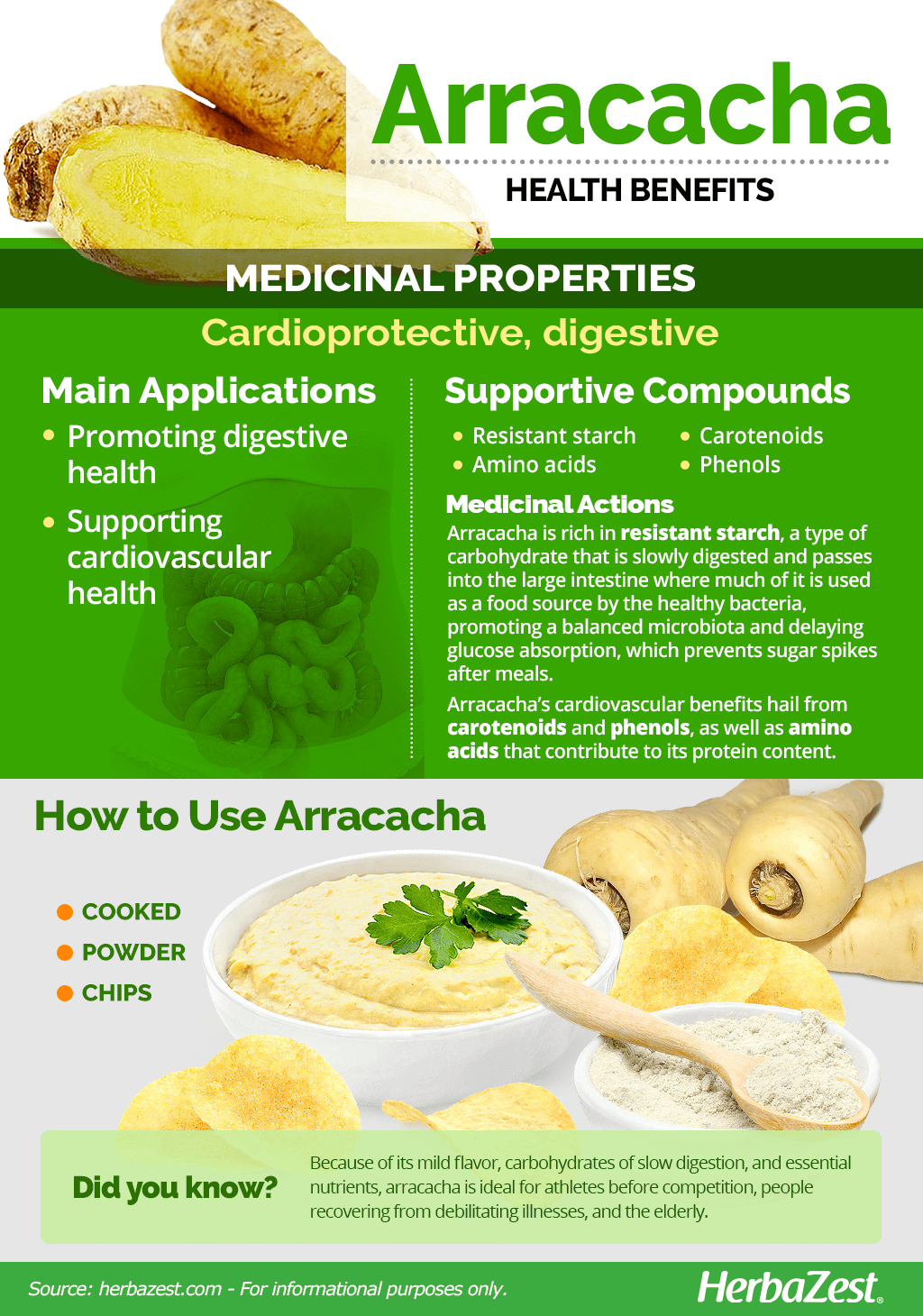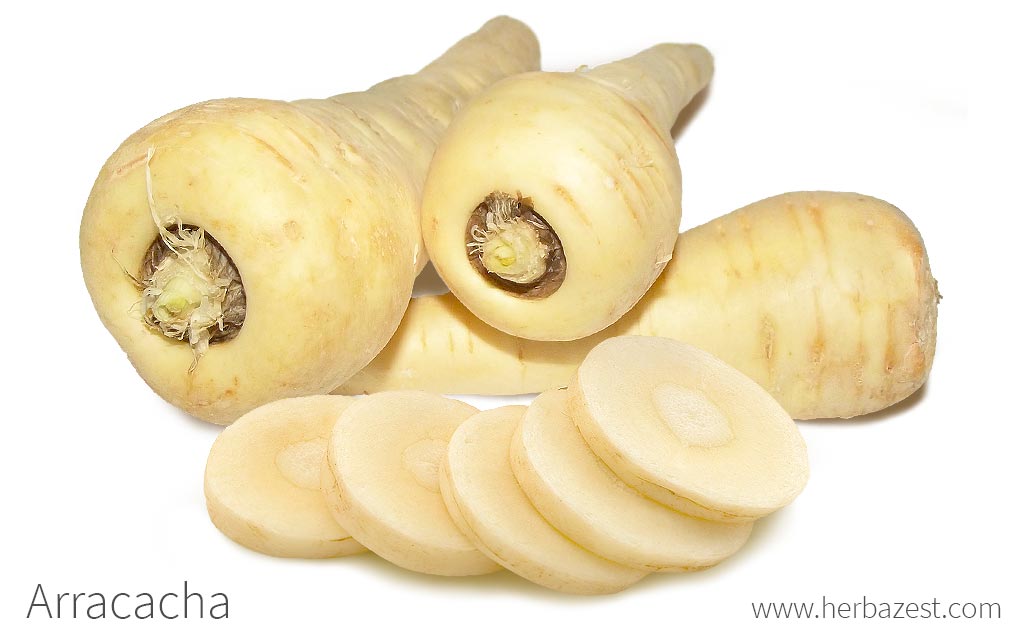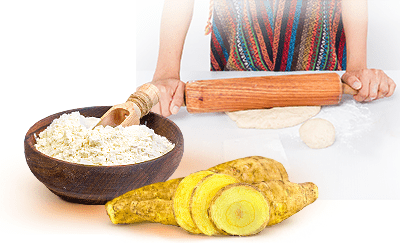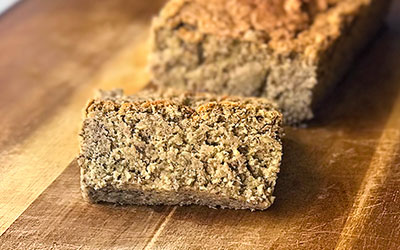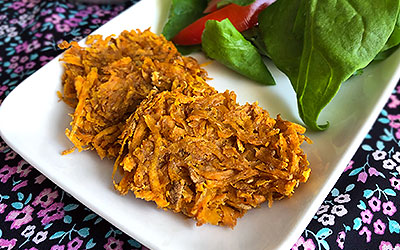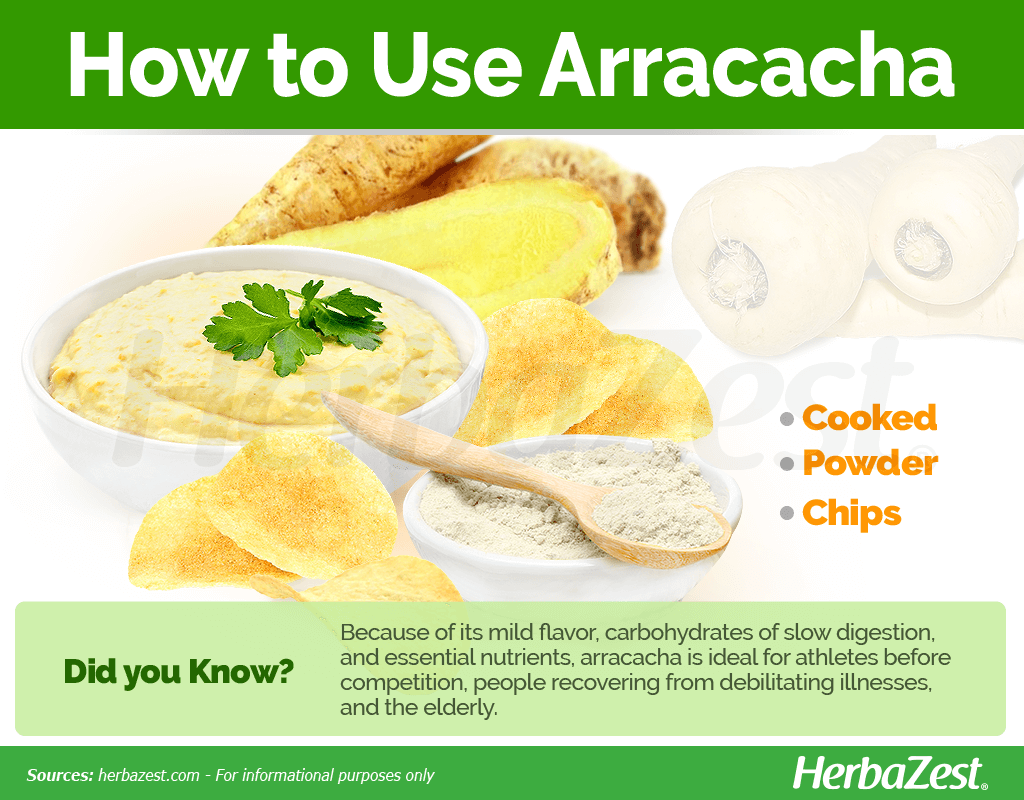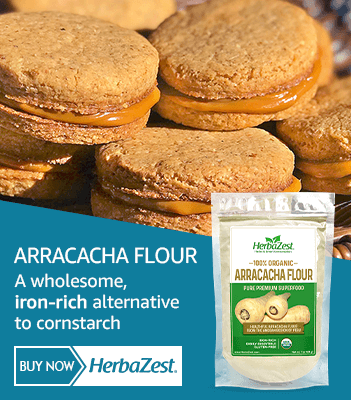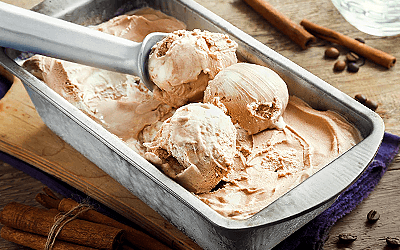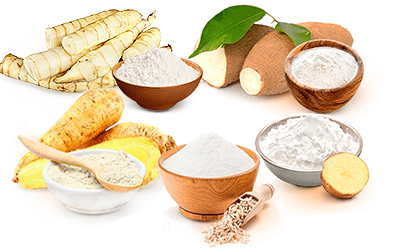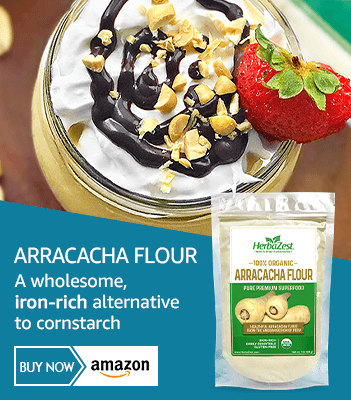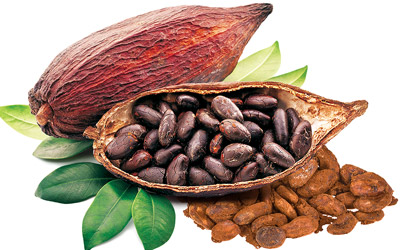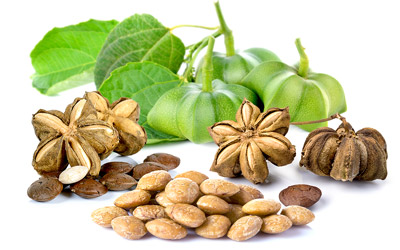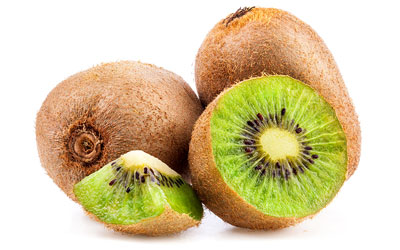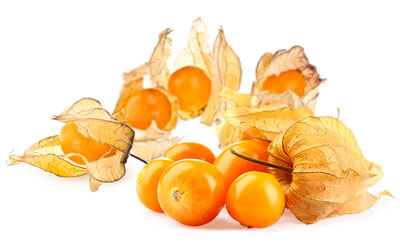Native to South America, particularly the Andean regions of Perú, Colombia, Ecuador, and Venezuela as well as subtropical areas of Brazil, arracacha has been used as both a culinary ingredient and a medicinal herb since ancient times. Outside of its native lands, it is known as Peruvian parsnip, Peruvian carrot, and white carrot.
Arracacha Medicinal Properties
- Medicinal action Cardioprotective, Digestive
- Key constituents Resistant starch, carotenoids, phenols, amino acids
- Ways to use Food, Powder
- Medicinal rating (2) Minorly useful plant
- Safety ranking Safe
Health Benefits of Arracacha
Although arracacha has been consumed in the Andes for centuries, its medicinal properties have not been studies extensively. However, since arracacha tuber belong to the same family as other root vegetables, they have been suggested they may provide the following benefits:
Promoting digestive health. Arracacha is rich in resistant starch, which promotes smooth digestion and a healthy intestinal flora, including relieving both constipation and diarrhea.
Supporting cardiovascular health. The nutritional content of arracacha supports cardiac function when this tuber is consumed as part of a healthy diet.
Arracacha's slowly digested starches help control sugar spikes after meals and provide a sensation of fullness that prevents food cravings throughout the day, thus aiding weight control.
Studies have also found that adding arracacha flour to baked goods increases their fiber content, while reducing their caloric value.1
Additionally, thanks to its mineral content, arracacha also helps prevent osteoporosis, promoting healthy bones.
How It Works
The most important compounds in arracacha are starches, which can be divided into rapidly digestible starch, slowly digestible starch, and resistant starch.2
Starches are complex carbohydrates, generally considered unhealthy for being an important source of glucose, which, if consumed in excess, can contribute to obesity, diabetes, and metabolic syndrome. However, arracacha is particularly rich in resistant starch, a type of carbohydrates that is slowly digested and passes into the large intestine where much of it is used as a food source by healthy bacteria. Working in a similar fashion of dietary fiber, arracacha's starch promotes a balanced microbiota and delays glucose absorption into the blood stream.3
Other compounds that may have some influence on arracacha's cardiovascular benefits are carotenoids and phenols as well as amino acids that contribute to its protein content.4
Other herbs with cardioprotective benefits are almonds, avocado, and sacha inchi, whereas amaranth, sweet potato, and yacon also promote digestive health.
Arracacha Side Effects
Arracacha is considered safe for general consumption, and no side effects have been reported.

Arracacha Nutrition
Arracacha provides a range of nutrients in moderated amounts as well as both soluble and insoluble fiber. Additionally, it is particularly high in carbohydrates of slow absorption, which contribute to prolonged satiety, smooth digestion, and reduced food cravings between meals.
Arracacha offers a wide range of minerals, mainly iron, which plays a critical role in the formation and transport of new red blood cells, helping treat and prevent anemia. Other minerals, present in adequate amounts in arracacha tubers, are calcium (for healthy bones and carbohydrate metabolism) and magnesium, which is essential for blood pressure regulation and reducing insulin resistance.
Fresh arracacha tubers provide good levels of vitamin C (ascorbic acid) and vitamins B-complex; however, when the pulp is dried and pulverized, the presence of these water-soluble nutrients gets significantly reduced, leaving moderate amounts of B3 (niacin).
100 GRAMS OF ARRACACHA ROOT PROVIDE 75 CALORIES, WHICH ARE MAINLY ATTRIBUTED TO CARBOHYDRATES (8% DV), DIETARY FIBER (3% DV), SUGARS (3% DV), AND PROTEINS (2% DV).
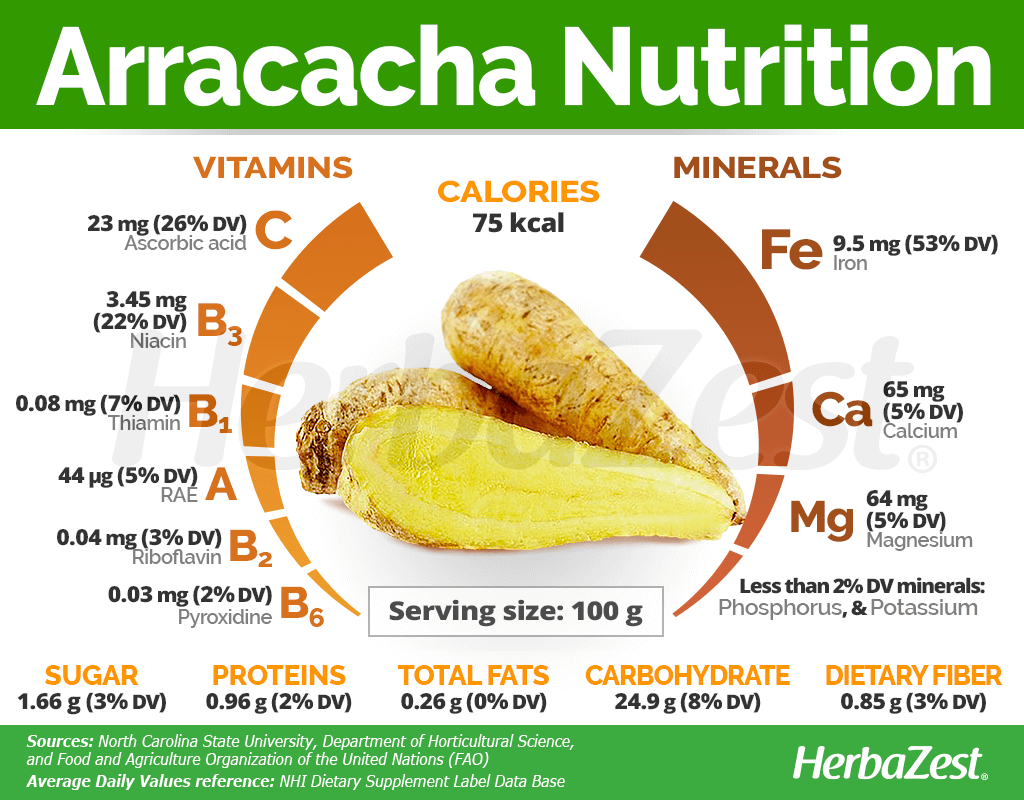
How to Consume Arracacha
- Taste Mild
Natural forms
Cooked. In their native Andean region, arracacha tuberous roots are popularly cooked and used in soups, stews, and desserts.
Powder. Obtained from dried and ground tubers, arracacha powder adds easily digestible carbohydrates and other important nutrients to a diet. It can be used to prepare porridge, mixed with mashed potatoes, and also added to soups and sauces as a natural thickener.
Chips. Smashed and dehydrated to make them crispy, arracacha chips are a popular snack, mostly in the areas where this Andean tuber grows.
BECAUSE OF ITS MILD FLAVOR, SLOW RELEASE CARBOHYDRATES, AND ESSENTIAL NUTRIENTS, ARRACACHA IS IDEAL FOR ATHLETES BEFORE COMPETITION, PEOPLE RECOVERING FROM DEBILITATING ILLNESSES, AND THE ELDERLY.
Growing
- Harvested parts Roots
- Light requirements Full sun
- Soil Light (sandy), Loamy sand, Well-drained
- Soil pH 5.1 – 5.5 (Strongly acidic), 5.6 – 6.0 (Moderately acidic)
- Growing habitat Subtropical regions, Andean region
- Growing time 6 to 10 months
- Propagation techniques Root cuttings
- Potential insect pests Insects
- Potential diseases Fungi, Bacterial wilt
Arracacha usually grows well in temperate Andean and subtropical regions. It can be cultivated like other roots vegetables, such as carrots, in a home garden. However, it is important to consider some basic requirements for soil, irrigation, temperature, and sun exposure for optimal results.
Growing Guidelines
Arracacha grows at an altitude of between 4921 and 9843 feet (1500-3000 m), with an optimum range of temperature between 57 and 70°F (14-21°C). While lower temperatures delay ripening of the roots and affect foliage growth, higher temperatures seem to reduce root size.
The ideal soil for arracacha is deep, fertile, well-drained, and sandy, with a pH of 5 to 6. Full sun and short days are required for good rooting.
The arracacha plant can be reproduced by seeds, but it is most commonly propagated by suckers or shoots.
Arracacha roots or tubers are usually harvested 6 to 10 months after planting, before inflorescence develops.
Arracacha is generally regarded as a robust crop with few disease or pest problems; however, it can be susceptible to insects, bacteria, and fungi.
Additional Information
- Other uses Animal feed
Plant Biology
Arracacha (Arracacia xanthorrhiza) is an herbaceous plant that can reach 1.6 to 4 ft (0.5-1.2 m) high, with a short, cylindrical stem that grows down to 10 cm and can reach a diameter of 10 cm, with numerous buds on the upper part. The parsley-like leaves are of green or bronze color, depending on the variety. Two kinds of roots emerge from the stem: long and fine ones or tuberous and fusiform ones. The latter are the usable part.
Classification
The genus Arracacia belongs to the large Apiaceae family, which comprises of about 3,700 species (mostly aromatic) spread over 434 genera, and it is home to many other economically-important herbs, such as anise (Pimpinella anisum), angelica (Angelica archangelica), carrot (Daucus carota) celery (Apium graveolens), fennel (Foeniculum vulgare), dill (Anethum graveolens), parsley (Petroselinum crispum), and osha (Ligusticum porteri).
Species of Arracacha
The Arracacia genus encompasses about 30 species, from Mexico and Central America to the Peruvian an Bolivian Andes, and at least nine of them native to South America; however, Arracacia xanthorrhiza is the only one cultivated at a commercial scale.
There are three main recognized varieties of arracacha, each of them easily identified by the color of their pulp, which can be white, yellow and purple, with many sub-varieties from each color.
Historical Information
Arracacha is arugably one of the oldest Andean crops, even preceding the domestication of the potato. While evidence is lacking, it is thought to have originated from the northern part of South America, mainly due to the abundance of other related species in that region.
Economic Data
The largest producer of arracacha in South America is Brazil, but this crop is also cultivated in Sri Lanka, the Antilles, and various countries of Central America and Africa.
Other Uses of Arracacha
Food industry. Some companies use arracacha powder in baby food's formula, and the gelatinous starches of this Andean tuber are being studied for other industrial applications.
Fodder. The plant's stem and leaves,as well as the stump or crown of the roots are used as animal fodder.
Sources
- Andean Roots and Tubers: Ahipa, Arracacha, Maca and Yacon, pp. 127-129
- Edible Medicinal And Non-Medicinal Plants, pp 361-366
- Food and Agriculture Organization (FAO), Starches and starchy roots
- Foods - Open Access Journal, Assessing the Nutritional Value of Root and Tuber Crops from Bolivia and Peru, 2019
- Harvard Health Publications, Carbohydrates — Good or Bad for You?
- Harvard T.H. Chan - School of Public Health, Ask the Expert: Legumes and Resistant Starch
- Heliyon, Chemical, structural, and thermal characterization of starches from four yellow Arracacha (Arracacia xanthorriza) roots produced in Colombia, 2020
- Invasive Species Compendium, Arracacia xanthorrhiza (arracacha)
- Neglected Crops: 1492 from a Different Perspective, pp 165–179
- North Carolina State University, Arracacha (Arracacia xanthorrhiza Bancroft)
Footnotes:
- The CEPPA Bulletin. (2016). Substitution of cornmeal for flour of shoots and non-commercial roots of arracacha (Arracaria xanthorrhiza Bancroft) in the processing of semisweet biscuits. Retrieved August 28, 2023, from https://revistas.ufpr.br/alimentos/article/view/48990
- Heliyon. (2020). Chemical, structural, and thermal characterization of starches from four yellow Arracacha (Arracacia xanthorriza) roots produced in Colombia. Retrieved August 31, 2020, from https://www.ncbi.nlm.nih.gov/pmc/articles/PMC7452578/
- Harvard T.H. Chan, School of Public Health. (n.d.). Ask the Expert: Legumes and Resistant Starch. Retrieved September 7, 2020, from https://www.hsph.harvard.edu/nutritionsource/2015/11/16/ask-the-expert-legumes-and-resistant-starch/
- Foods. (2019). Assessing the Nutritional Value of Root and Tuber Crops from Bolivia and Peru. Retrieved September 7, 2020, from https://www.ncbi.nlm.nih.gov/pmc/articles/PMC6915682/
